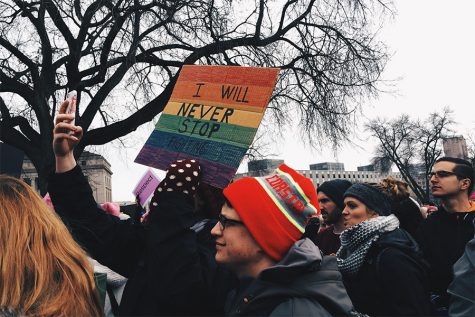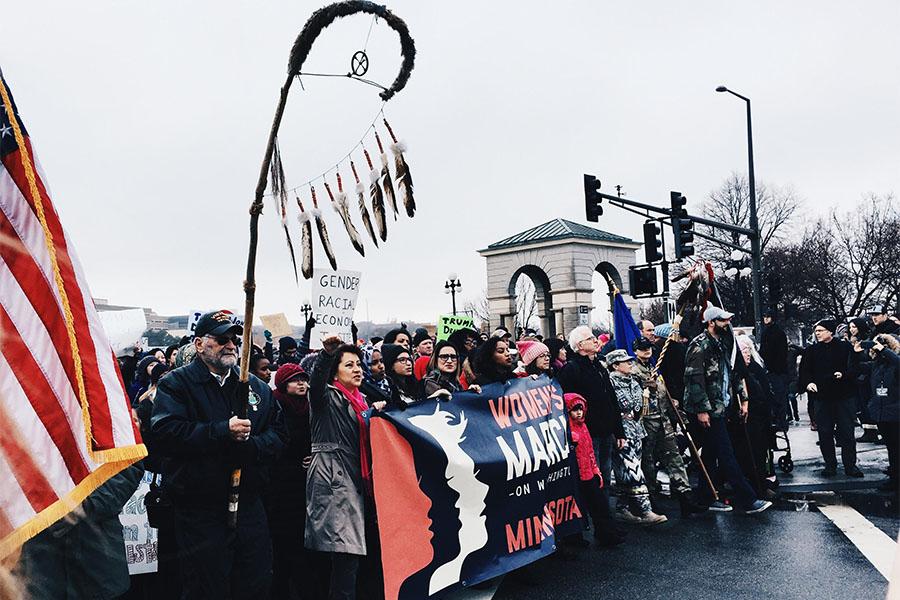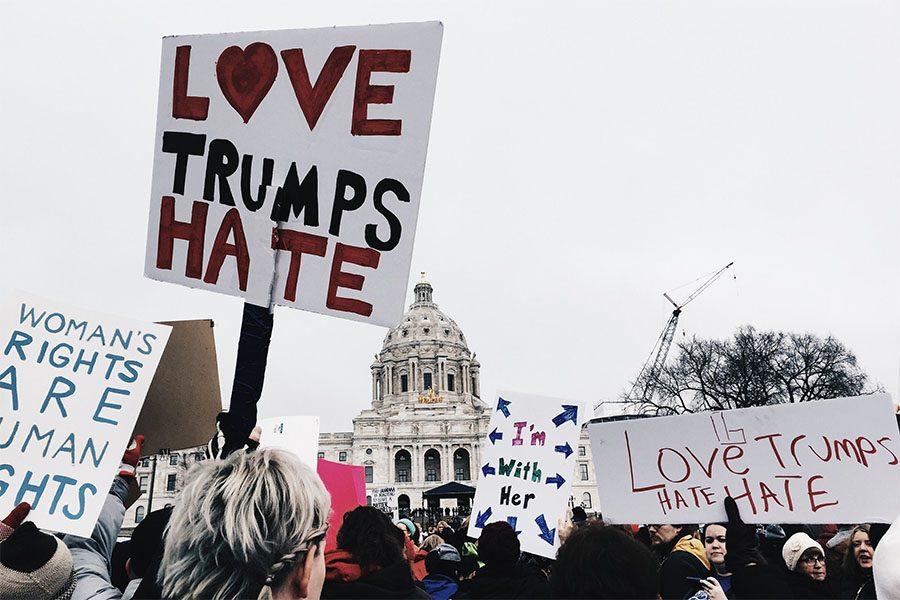Women’s March: Minneapolis
Two OHS students share their experience
January 27, 2017
The news cycle seen throughout this election was an especially unique one. The next four years are looking like they’re going to be different than any other presidential term America has had. On Jan.21, one day after President Trump was inaugurated, 3.3 million women came together to protest with Women’s Marches. These marches have been the biggest protest in American history. At least one march took place in each state in about 500 different US cities. There were also at least 700 international marches in 60 different countries on every continent, even Antarctica, where citizens joined Americans in protest. The purpose of these marches was to spread awareness about the issue of discrimination against women and gender or race inequality, which have long been protested. On the campaign trail, some of the acts Trump was promising to repeal or overturn have much to do with women and taking away some of their freedoms, like abortion rights, for example, giving protesters a reason to backlash. The men and women who joined these marches were not afraid to stand up for what they believe in. Magnet asked two OHS students about their experiences at the Minneapolis march.*
Madison Bissonette
Madison Bissonette is a junior at OHS and shared her version of the experience. She went to the Minneapolis March with her mom.
She first learned about the March itself from the news, but thought it was only in Washington D.C. She found out the day of that there was one in Minneapolis and her and her mom decided to go. 60,000 people showed up, to the march even though there were only 20,000 RSVPs.
The atmosphere was very peaceful and there was an overwhelming sense of community. “Everyone was excited and there was a lot of energy. Everyone felt connected and it was a very welcoming environment,” said Bissonette. On the way there, there were homeless people and protesters gave them things like food or money. “I’ve never seen that many people be so giving. The whole thing was just really powerful and really positive. It was a good experience. It felt like a very safe environment,” she said. There was only one arrest. According to Twin Cities’ Pioneer Press, it man was allegedly spraying pepper spray at protesters.
The large rally turnout was more than what the city had planned for. They had to take a bus to get to where the march was starting. “At each bus stop there were protesters trying to get on the bus. We had to tell them that there’s not enough room on the bus, but that there was, like, three more busses coming. There were just a ton of people. There were a lot of men there, too, which was surprising to me,” said Bissonette.
People brought signs, flags, drums and tambourines to accompany their marching.
There was a myriad of reasons why people were there. Some with dislike for President Trump, some with agendas for reproductive rights, and activists like Black Lives Matter.

A man holds up a sign that says “hate does not make America great”
“There was a huge variety of signs there. Some were funny, some were more about American’s views. Some were about women’s rights, some said, ‘Black Lives Matter’. There were a lot of ones that said, ‘Love trumps hate’ and ‘We love our Muslim neighbors’. There were some that said things supporting Hillary, too, like, ‘I’m with her’, ‘I’m a nasty woman’, or ‘My body my choice’,” said Bissonette.
The protesters chanted a plethora of things while marching, as well. “One was where someone would yell ‘show me what democracy looks like’ and then everyone would yell ‘this is what democracy looks like’. A lot of women chanted ‘my body my choice’,” said Bissonette. “We also chanted things like ‘no hate, no fear, immigrants are welcome here’, and ‘no trump, no KKK, no racist USA’.”
They marched from St. Paul College to the capitol (just over half a mile) where there were speakers. These people spoke about their views and broadcasted their voices miles from where they were standing, adding to the energy.
One was the CEO of Planned Parenthood Minnesota, Sarah Stoesz. Others included women senators such as Patricia Torres Ray and Sandy Pappus, a speaker that represented the deaf community and a Native American man who sang about the pipeline. Kamala Harris, a US senator from California, talked about how many of them there were, how much they can do, and how much power they have together, really adding to the sense of unity.
Katie Segler
Katie Segler is a senior at OHS. She went to the march with a friend that graduated in 2016, her cousin and her mom.
She had a similar experience to Bissonette. Segler said, “The atmosphere was extremely positive and empowering. It felt like just by being there, we could cause change. The feeling is really hard to describe. I’ve never felt anything like it! You could truly feel all the love surrounding you.”
She first heard about it through social media and knew about the march in Washington D.C., but didn’t realize they were happening all around the nation and world. “Once I saw the event on Facebook, I read more about it and it was an opportunity I couldn’t pass up,” she said.
They drove to the U of M to park, and then planned on taking the transit to the march. She also didn’t realize the multitude of people that would be there. Just on the U campus they saw tons of people carrying signs.

A person takes a picture of their signs that says “I will never stop fighting”
“We ended up waiting for four trains before we could jam ourselves on one! From there, the whole train was packed full of women and men going to the march. Once we got there, we walked to the start of the march and just jumped in. There were people everywhere with all types of signs and cameras. The walk itself was pretty short since there were so many people!” said Segler.
During the march, they held up their signs and cheered. They walked together all the way to the front of the capital and gathered there. “Different speakers spoke and musicians sang. It was extremely inspiring and motivational. My favorite speaker was Ilhan Omar. She was incredible, I will be forever grateful I got to hear her talk,” said Segler. Sen. Omar is the first senator of Somali background as well as an idol for feminists across the country.
There was a rally after they marched that was held in front of the capital for a few hours while different speakers talked about women’s rights and their personal challenges they have faced or overcome. Segler also commented on the signs,”I saw all types of signs. Some examples of things that were on signs were, ‘My body, my choice’, ‘This is what a feminist looks like’, ‘Nasty woman’, and ‘Pizza rolls not gender roles’. There were climate change awareness signs, pro-choice signs, no DAPL signs. Honestly, anything you could think of was on a sign! The sign I brought said, ‘Nasty woman unite’.”
Although the right to protest is given to Americans, it is not often we see such large groups stand up for their beliefs. This protest was the largest in history. It included these two OHS students, as well as countless other people. This protest made a large difference in each participant’s life, and was a clear step towards turning the world into one these protesters aim to have.
*Editor’s Note: The views expressed by the students in this article are not necessarily the views of the Magnet staff.


